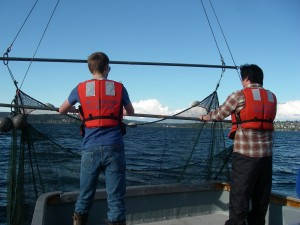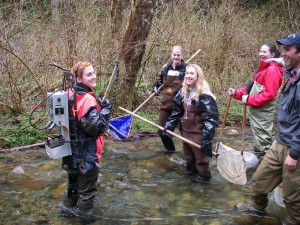FISH 450

FISH 450 students sampling fishes in Lake Washington
The purpose of this class is to familiarize students with the life history, behavior, and ecology of Pacific salmon and trout. The lectures provide detailed information on the marine distribution, homing migration, energetics, and spawning behavior of adult salmon, the ecological processes linked to their carcasses, the incubation and emergence of their offspring from gravel nests, the ecology of juveniles in streams and lakes, their seaward migration, and ecology at sea. This class is fast-paced and information rich, and it is expected that students are already familiar with fish biology and ecological principles, and have also had experience processing data and writing scientific papers.
Lecture Topics
-
- Introduction, goals and course schedule
- General life history & distribution of Oncorhynchus, Salmo and Salvelinus
- Life histories and identification, continued
- Life histories compared with other N. A. fishes
- Global patterns of anadromy and catadromy; Speciation, glaciation
- Oceanic migration and orientation
- Coastal and estuarine migrations
- Upriver migrations, energetics, hormones
- Homing – evidence and patterns
- Homing mechanisms
- Selection of spawning site and female reproductive behavior
- Reproductive success of males
- Ecology of adult salmon: predators, scavengers and nutrient cycling
- Embryo mortality and incubation schedules
- Emergence and initial fry movements
- Sockeye fry in lakes: predation and feeding
- Salmon and trout in streams Part I & II
- Smolt transformation & physiology
- Seaward migration: timing, orientation
- Estuarine residence and migration
- Early marine migrations and distribution
- Survival at sea
- Feeding and growth at sea
- Age and size at maturity
- Population structure and local adaptation
- Successes and failures of transplants
- Effects of land-use activities on salmonids
- Wild salmon and hatcheries
- The future of salmon in a changing world
Field Trips

FISH 450 students sampling fishes in Rock Creek, Washington
The field trips go to a stream to sample fishes and the available habitat to assess the extent to which salmonid species segregate from each other, and from older/younger members of their species. We then sample on Lake Washington to examine the diel vertical movements and feeding by juvenile sockeye salmon and inter-specific competitors (longfin smelt and three-spine stickleback). We also view reproductive behavior at the Weaver Creek Spawning Channel in southern British Columbia.